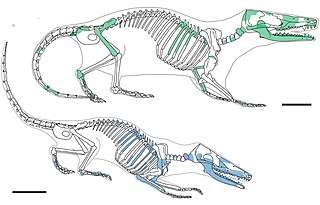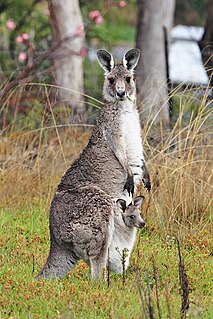Related Research Articles

Cimolodonta is a taxon of extinct mammals that lived from the Cretaceous to the Eocene. They were some of the more derived members of the extinct order Multituberculata. They probably lived something of a rodent-like existence until their ecological niche was assumed by true rodents. The more basal multituberculates are found in a different suborder, "Plagiaulacida", a paraphyletic group containing all non cimolodontan multituberculates.

Plagiaulacida is a group of extinct multituberculate mammals. Multituberculates were among the most common mammals of the Mesozoic, "the age of the dinosaurs". Plagiaulacids are a paraphyletic grouping, containing all multituberculates that lie outside of the advanced group Cimolodonta. They ranged from the Middle Jurassic Period to the early Late Cretaceous of the northern hemisphere. During the Cenomanian, they were replaced by the more advanced cimolodontans.

Docodonta is an order of extinct mammaliaforms that lived during the Mesozoic, from the Middle Jurassic to Early Cretaceous. They are distinguished from other early mammaliaforms by their relatively complex molar teeth, from which the order gets its name. Until recently, Docodonta were represented primarily by teeth and jaws found across former Laurasia,. However, recent discoveries in China include some exceptionally well preserved, almost complete body fossils.

Eutriconodonta is an order of early mammals. Eutriconodonts existed in Asia, Africa, Europe, North and South America during the Jurassic and the Cretaceous periods. The order was named by Kermack et al. in 1973 as a replacement name for the paraphyletic Triconodonta.
Haramiyidans were a long lived lineage of mammaliaform cynodonts or mammals. Their teeth, which are by far the most common remains, resemble those of the multituberculates. However, based on Haramiyavia, the jaw is less derived; and at the level of evolution of earlier basal mammals like Morganucodon and Kuehneotherium, with a groove for ear ossicles on the dentary. If they are early multituberculates, they would be the longest lived mammalian clade of all time. However, a more recent study, in November 2015, may dispute this and suggested the Haramiyida were not crown mammals, but were part of an earlier offshoot of mammaliaformes instead.
Gobiconodon is an extinct genus of carnivorous mammal from the Middle Jurassic to Early Cretaceous. It weighed 10–12 pounds (4.5–5.4 kg) and measured 18–20 inches (460–510 mm). It was one of the largest mammals known from the Mesozoic. Like other gobiconodontids, it possesses several speciations towards carnivory, such as shearing molar teeth, large canine-like incisors and powerful jaw and forelimb musculature, indicating that it probably fed on vertebrate prey; rather uniquely among predatory mammals and other eutriconodonts, the lower canines were vestigial, with the first lower incisor pair having become massive and canine-like. Like the larger Repenomamus there might be some evidence of scavenging.
Deltatheroida is an extinct group of basal metatherians that were distantly related to modern marsupials. The majority of known members of the group lived in the Cretaceous; one species, Gurbanodelta kara, is known from the late Paleocene (Gashatan) of China. Their fossils are restricted to Central Asia and North America. This order can be defined as all metatherians closer to Deltatheridium than to Marsupialia.

Dryolestida is an extinct order of mammals; most of the members are mostly known from the Jurassic to Paleogene, with one member, Necrolestes, surviving as late as the early Miocene. They are considered members of the clade Cladotheria, close to the ancestry of therian mammals. It is also believed that they developed a fully mammalian jaw and also had the three middle ear bones. Other than that, not much is known about them, because their fossils are made up mostly of jaw and tooth remains.

Morganucodonta is an extinct order of basal Mammaliaformes, a group including crown-group mammals (Mammalia) and their close relatives. Their remains have been found in Southern Africa, Western Europe, North America, India and China. The morganucodontans were probably insectivorous and nocturnal, though like eutriconodonts some species attained large sizes and were carnivorous. Nocturnality is believed to have evolved in the earliest mammals in the Triassic as a specialisation that allowed them to exploit a safer, night-time niche, while most larger predators were likely to have been active during the day.

Trechnotheria is a group of mammals that includes the therians and some fossil mammals from the Mesozoic Era. In the Jurassic through Cretaceous periods, the group was endemic to what would be Asia and Africa.

Ambondro mahabo is a mammal from the Middle Jurassic (Bathonian) Isalo III Formation of Madagascar. The only described species of the genus Ambondro, it is known from a fragmentary lower jaw with three teeth, interpreted as the last premolar and the first two molars. The premolar consists of a central cusp with one or two smaller cusps and a cingulum (shelf) on the inner, or lingual, side of the tooth. The molars also have such a lingual cingulum. They consist of two groups of cusps: a trigonid of three cusps at the front and a talonid with a main cusp, a smaller cusp, and a crest at the back. Features of the talonid suggest that Ambondro had tribosphenic molars, the basic arrangement of molar features also present in marsupial and placental mammals. It is the oldest known mammal with putatively tribosphenic teeth; at the time of its discovery it antedated the second oldest example by about 25 million years.
Triconodontidae is an extinct family of small, carnivorous mammals belonging to the order Eutriconodonta, endemic to what would become Asia, Europe, North America and probably also Africa and South America during the Jurassic through Cretaceous periods at least from 190–70.6 mya.
Several mammals are known from the Mesozoic of Madagascar. The Bathonian Ambondro, known from a piece of jaw with three teeth, is the earliest known mammal with molars showing the modern, tribosphenic pattern that is characteristic of marsupial and placental mammals. Interpretations of its affinities have differed; one proposal places it in a group known as Australosphenida with other Mesozoic tribosphenic mammals from the southern continents (Gondwana) as well as the monotremes, while others favor closer affinities with northern (Laurasian) tribosphenic mammals or specifically with placentals. At least five species are known from the Maastrichtian, including a yet undescribed species known from a nearly complete skeleton that may represent a completely new group of mammals. The gondwanathere Lavanify, known from two teeth, is most closely related to other gondwanatheres found in India and Argentina. Two other teeth may represent another gondwanathere or a different kind of mammal. One molar fragment is one of the few known remains of a multituberculate mammal from Gondwana and another has been interpreted as either a marsupial or a placental.
The Amphidontidae are a family of extinct mammals from the Early Cretaceous, belonging to the triconodonts. It contains most of the species previously belonged to Amphilestidae.

Necrolestes is an extinct genus of non-therian mammals, which lived during the Early Miocene in what is now Argentine Patagonia. It contains two species, N. patagonensis and N. mirabilis, and is the most recent known genus of dryolestoid. The type species N. patagonensis was named by Florentino Ameghino in 1891 based on remains found by his brother, Carlos Ameghino in Patagonia. Fossils of Necrolestes have been found in the Sarmiento and Santa Cruz Formations.

Yinotheria is a proposed basal subclass clade of crown mammals uniting the Shuotheriidae, an extinct group of mammals from the Jurassic of Eurasia, with Australosphenida, a group of mammals known from the Jurassic to present of Gondwana, including living monotremes. Today, there are only five surviving species of monotremes which live in Australia and New Guinea, consisting of the platypus and four species of echidna. Fossils of yinotheres have been found in England, China, Russia, Madagascar and Argentina. Contrary to other known crown mammals, they retained postdentary bones as shown by the presence of a postdentary trough. The extant members (monotremes) developed the mammalian middle ear independently.
Spalacotherium is a genus of extinct mammal from the Early Cretaceous of Europe. The type species Spalacotherium tricuspidens was originally named by Richard Owen in 1854, and its material includes maxillary and dentary fragments and many teeth from the Berriasian Lulworth Formation of southern England. Referred species include S. taylori, S. evansae and S. hookeri also from the Lulworth deposits, and S. henkeli from Barremian deposits of Galve, Spain. The Lulworth taxon Peralestes longirostris, named by Owen in 1871, is a junior synonym of the type species S. tricuspidens. Spalacotherium is the namesake taxon of the family Spalacotheriidae, which is an extinct clade within Trechnotheria that may be closely related to the Gondwanan clade Meridiolestida, or united with the family Zhangheotheriidae to form Symmetrodonta.S. evansae is also from the Berriasian aged Angeac-Charente bonebed in western France.
Thereuodon is a genus of extinct mammal known from the Early Cretaceous of southern England and Morocco. The type species, named by Denise Sigogneau-Russell in 1989 for teeth from the earliest Cretaceous Ksar Metlili Formation of Morocco, is Thereuodon dahmani, while the referred species named by Sigogneau-Russell and Paul Ensom for teeth from the Lulworth Formation of England is Thereuodon taraktes. The two species are separated by a break in the cingulum in T. dahmani, a more obsute medial crest in T. taraktes, a duller stylocone in T. taraktes, a "c" cuspule in T. dahmani, and a reduced facet A in T. taraktes. The genus Thereuodon is the only taxon in the symmetrodont family Thereuodontidae, which may be closely related to Spalacotheriidae. Tooth referred to T. cf. taraktes is known from the Berriasian aged Angeac-Charente bonebed of France.
References
- ↑ Mikko's Phylogeny Archive Haaramo, Mikko (2007). "Mammaliaformes – mammals and near-mammals" . Retrieved 30 December 2015.